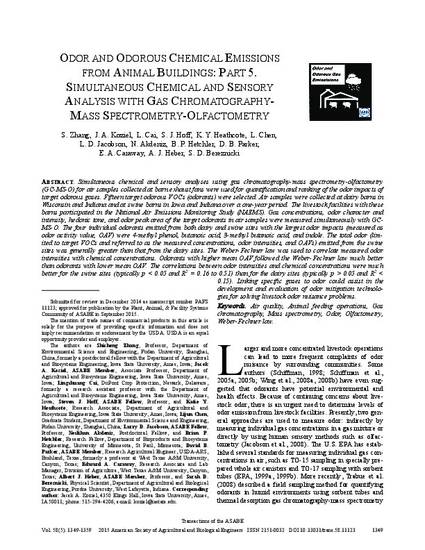
Simultaneous chemical and sensory analyses using gas chromatography-mass spectrometry-olfactometry (GC-MS-O) for air samples collected at barn exhaust fans were used for quantification and ranking of the odor impacts of target odorous gases. Fifteen target odorous VOCs (odorants) were selected. Air samples were collected at dairy barns in Wisconsin and Indiana and at swine barns in Iowa and Indiana over a one-year period. The livestock facilities with these barns participated in the National Air Emissions Monitoring Study (NAEMS). Gas concentrations, odor character and intensity, hedonic tone, and odor peak area of the target odorants in air samples were measured simultaneously with GC-MS-O. The four individual odorants emitted from both dairy and swine sites with the largest odor impacts (measured as odor activity value, OAV) were 4-methyl phenol, butanoic acid, 3-methyl butanoic acid, and indole. The total odor (limited to target VOCs and referred to as the measured concentrations, odor intensities, and OAVs) emitted from the swine sites was generally greater than that from the dairy sites. The Weber-Fechner law was used to correlate measured odor intensities with chemical concentrations. Odorants with higher mean OAV followed the Weber-Fechner law much better than odorants with lower mean OAV. The correlations between odor intensities and chemical concentrations were much better for the swine sites (typically p < 0.05 and R2 = 0.16 to 0.51) than for the dairy sites (typically p > 0.05 and R2 < 0.15). Linking specific gases to odor could assist in the development and evaluation of odor mitigation technologies for solving livestock odor nuisance problems.
Available at: http://works.bepress.com/steven_hoff/129/

This article is from Transactions of the ASABE 58(5): 1349-1359 (doi: 10.13031/trans.58.11123). Posted with permission.